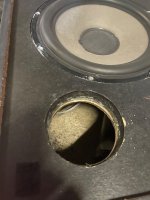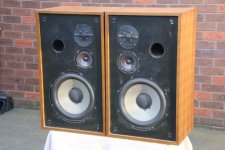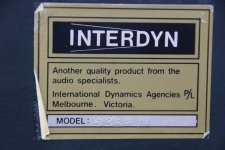I picked up some vintage speakers this week, they sound pretty good but have corrosion on the driver frames so I wanted to take them out, clean up and check the crossovers while I’m there.
I’ve undone the screws and realised all of the drivers have had silicone applied at some stage by a previous owner. They aren’t going anywhere…
Has anyone got any experience or suggestions on how to remove them without damage?
The drivers have been rebated into the baffle btw…
I’ve undone the screws and realised all of the drivers have had silicone applied at some stage by a previous owner. They aren’t going anywhere…
Has anyone got any experience or suggestions on how to remove them without damage?
The drivers have been rebated into the baffle btw…
No bites…
I just did some research on the caps and popular opinion says I should replace the Elcaps so I guess I’m going to have to open them up.
Also I am guessing the inductors are on the other side of the board.
I just did some research on the caps and popular opinion says I should replace the Elcaps so I guess I’m going to have to open them up.
Also I am guessing the inductors are on the other side of the board.
It's pretty common in less expensive speakers to have only a capacitor on the tweeter as the crossover (or capacitors on midrange and tweeter in a 3-way). This is also sometimes done on minimalist speaker designs. You're asking us to speculate about things we can't see, so obviously this may not apply to your situation.
We don't know the circuit, the speaker type, or much else, so it's also hard to say what's useful. Some would tell you to just leave them alone if they sound good. Others seem convinced expensive capacitors make everything sound better. If you like tweaking things and enjoy the process, have at it. If you're a more casual listener and find the speakers satisfying, there's nothing wrong with leaving them as is.
On the silicone front, there are products made to soften silicone and other kinds of caulk, but in your case you don't have access to much of the silicone surface area, so I'm not sure they'll do much. They may damage the cabinet also. I was always dumbfounded that anyone would suggest siliconing drivers into cabinets, but it seemed to be a thing for a while. It's hard enough to get drivers out with a simple stuck gasket - add silicone and it's a tall order to get them out without damaging everything involved.
We don't know the circuit, the speaker type, or much else, so it's also hard to say what's useful. Some would tell you to just leave them alone if they sound good. Others seem convinced expensive capacitors make everything sound better. If you like tweaking things and enjoy the process, have at it. If you're a more casual listener and find the speakers satisfying, there's nothing wrong with leaving them as is.
On the silicone front, there are products made to soften silicone and other kinds of caulk, but in your case you don't have access to much of the silicone surface area, so I'm not sure they'll do much. They may damage the cabinet also. I was always dumbfounded that anyone would suggest siliconing drivers into cabinets, but it seemed to be a thing for a while. It's hard enough to get drivers out with a simple stuck gasket - add silicone and it's a tall order to get them out without damaging everything involved.
I managed to prise them out using a flat screwdriver on the edge levering against a paint scraper to prevent (much) damage to the timber. Speakers are all SEAS dated 1976.
As suspected there are 3 inductors on the other side of the crossover board, which has a printed circuit on it, so I’m guessing some expense involved. It has 7 capacitors and 3 resistors which suggests it’s probably a reasonably complex setup.
I’ll be replacing the caps…
As suspected there are 3 inductors on the other side of the crossover board, which has a printed circuit on it, so I’m guessing some expense involved. It has 7 capacitors and 3 resistors which suggests it’s probably a reasonably complex setup.
I’ll be replacing the caps…
Yes, they are. They do sound good, but I’m wondering about the Elcaps since they are close to 50 years old now…!
I’ve managed to get the cases open so will trace out the design for the crossover. I wonder if there’s a good reason they’ve used both electrolytic and polypropylene caps in the original design.
I’ve managed to get the cases open so will trace out the design for the crossover. I wonder if there’s a good reason they’ve used both electrolytic and polypropylene caps in the original design.
Probably cost; 20 microfarads is a high (i.e. expensive) value for a poly cap. However, as shunt parts in a woofer circuit, for example, electrolytics are fine.
I'm guessing they're three way speakers? If so, they're probably Interdyn 'P' series, their top range, and you have yourself a bargain.
We have a pair of Interdyn Pee Wee monitors from that era which came with the very cheapest XO parts, although they still sounded good. Replacing them with ordinary Dayton parts of the same value noticeably improved the sound for around $10, as the 'carefully designed' crossover only had a cap and resistor which belonged in a toaster!
Aranmar Acoustics, which did many of Encel's speakers, may still be around and perhaps still have the XO details, worth a try.
Geoff
I'm guessing they're three way speakers? If so, they're probably Interdyn 'P' series, their top range, and you have yourself a bargain.
We have a pair of Interdyn Pee Wee monitors from that era which came with the very cheapest XO parts, although they still sounded good. Replacing them with ordinary Dayton parts of the same value noticeably improved the sound for around $10, as the 'carefully designed' crossover only had a cap and resistor which belonged in a toaster!
Aranmar Acoustics, which did many of Encel's speakers, may still be around and perhaps still have the XO details, worth a try.
Geoff
Yes, it’s a 3 way, but I think even before the P33.
I emails Aranmar today, will see how that goes.
I emails Aranmar today, will see how that goes.
Alex Encel is an absolute gentleman; when you visited his shop in Richmond he would often help you himself.
After I bought my first system from Encel, I wrote a quick 'thank you' letter for the service and advice; when you bought a system from them, Encel would come to your house and set it up - for free.
A few days after my letter, Alex rang to ask me if it would be OK to print it in The Age 'Green Guide' and offered to exchange my new turntable (a Garrard rim drive) for a better one, a Connoiseur BD2a. Who else would have done that?
Years later, after Encel had closed down, I had a problem with an FBR I bought through Interdyn - the issue was my fault - and couldn't get a replacement part. I complained to Interdyn and the next day got a call from Mr Encel in response. He arranged to get a new part from the US and it was shipped to me at no charge!
Can you imagine a nameless big box store doing that?
Geoff
After I bought my first system from Encel, I wrote a quick 'thank you' letter for the service and advice; when you bought a system from them, Encel would come to your house and set it up - for free.
A few days after my letter, Alex rang to ask me if it would be OK to print it in The Age 'Green Guide' and offered to exchange my new turntable (a Garrard rim drive) for a better one, a Connoiseur BD2a. Who else would have done that?
Years later, after Encel had closed down, I had a problem with an FBR I bought through Interdyn - the issue was my fault - and couldn't get a replacement part. I complained to Interdyn and the next day got a call from Mr Encel in response. He arranged to get a new part from the US and it was shipped to me at no charge!
Can you imagine a nameless big box store doing that?
Geoff
Any sort of service like that is hard to find, it’s a distant fond memory now. “Ian” was the salesman I remember most.
I used to look forward to Thursday’s green guide, as a student I could not afford much and was always looking for a bargain. They were also very happy to let me know of trade ins which is how I bought my first system until I eventually was able to buy new. I still have the Luxman amp and Advent speakers I bought there new, and have restored twice now…
I used to look forward to Thursday’s green guide, as a student I could not afford much and was always looking for a bargain. They were also very happy to let me know of trade ins which is how I bought my first system until I eventually was able to buy new. I still have the Luxman amp and Advent speakers I bought there new, and have restored twice now…
That might have been Ian Hooper, a tall skinny bloke who did the setups. First system was the Garrard turntable, a s/h Rotel 10w per channel amp and Interdyn 210 (twin cone 8") speakers. Total cost in 1976 : $280.
Alex threw in a really nice Supex cartridge with the Connoiseur, so the difference in sound from the Garrard was amazing.
I dreamed of owning Luxman and years later bought a cassette deck, it was excellent. Always bought my stuff from Encel until it closed.
Geoff
Alex threw in a really nice Supex cartridge with the Connoiseur, so the difference in sound from the Garrard was amazing.
I dreamed of owning Luxman and years later bought a cassette deck, it was excellent. Always bought my stuff from Encel until it closed.
Geoff
Just before the closure I bought my TT from them.
Just a cheap Project Basic but the service I got and the attention to detail was superb
Just a cheap Project Basic but the service I got and the attention to detail was superb
I’ve traced the crossover.
The electrolytics are not directly in the signal path whilst the polys are. I guess that makes sense, will swap the Elcaps with like for like values but just using the Jantzen/MDL ones.
I’m not sure what everything else is doing here, might look up some designs tomorrow.
The SEAS recommended crossover points for this 3 way was 800Hz and 4kHz. I don’t know the inductor values but have ordered a reader - just for curiosity as I won’t be changing these.

The electrolytics are not directly in the signal path whilst the polys are. I guess that makes sense, will swap the Elcaps with like for like values but just using the Jantzen/MDL ones.
I’m not sure what everything else is doing here, might look up some designs tomorrow.
The SEAS recommended crossover points for this 3 way was 800Hz and 4kHz. I don’t know the inductor values but have ordered a reader - just for curiosity as I won’t be changing these.
Looks a pretty thorough crossover for the time - I suspect most of the commercial three ways from that era were like my Pee Wees, with minimal parts.
Are these your speakers?
Geoff
Are these your speakers?
Geoff
Attachments
Last edited:
No, they are not P33, I think these pre-date those. The drivers were made in 1976. The veneer had been painted over but after sanding they are coming up ok.


I would definitely replace all the ELCAP's, especially the two 20uF, they have been receiving the full voltage across the woofer for years!I’ve traced the crossover.
The electrolytics are not directly in the signal path whilst the polys are. I guess that makes sense, will swap the Elcaps with like for like values but just using the Jantzen/MDL ones.
I’m not sure what everything else is doing here, might look up some designs tomorrow.
The SEAS recommended crossover points for this 3 way was 800Hz and 4kHz. I don’t know the inductor values but have ordered a reader - just for curiosity as I won’t be changing these.
View attachment 1369695
Simply buy 100V > 22 & 33uF electrolytic bipolars from Jaycar 🙂
Could be SEAS 60s, I had an optic on Google and the cabinets look the same as yours.
Upgrading the electrolytics from Jaycar should cost less than $10. However, I'd spend the extra on Jantzens from Speakerbug: around twice the price of Jaycar but possibly better quality; I've always been happy with their service.
https://speakerbug.com.au/index.php?route=product/category&path=25_29
Having said that, I used the Jaycar generic electrolytics in my Classix II speakers and they seemed to work fine.
Geoff
Upgrading the electrolytics from Jaycar should cost less than $10. However, I'd spend the extra on Jantzens from Speakerbug: around twice the price of Jaycar but possibly better quality; I've always been happy with their service.
https://speakerbug.com.au/index.php?route=product/category&path=25_29
Having said that, I used the Jaycar generic electrolytics in my Classix II speakers and they seemed to work fine.
Geoff
I believe this model is called 33R-9, there’s some writing inside the cabinet.
I also believe the MDL caps in Jaycar are made by Jantzen, there’s lots of reference s online (both green and black). 10% tolerance makes up for them being 10% higher in value than what they are replacing.
I also believe the MDL caps in Jaycar are made by Jantzen, there’s lots of reference s online (both green and black). 10% tolerance makes up for them being 10% higher in value than what they are replacing.
- Home
- Loudspeakers
- Multi-Way
- Siliconed drivers


